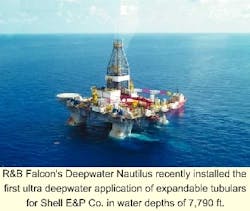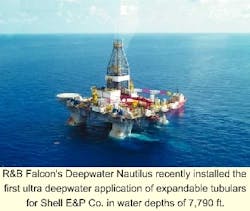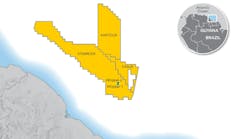With the installation of the Brutus tension leg platform (TLP) in the third quarter of next year, Shell will have five TLPs operating in the US Gulf of Mexico. "We like TLPs," said Dave Lawrence, Vice-President of Exploration and Development for Shell E&P. That is why it is a little surprising the company went a different direction with its Na Kika hub. -
The semisubmersible-shaped structure will be permanently moored in 6,300-ft water depth. "You are probably aware that from a cost standpoint, it wouldn't make much sense to put a TLP out in these water depths. TLPs reach their economic limit in water depths of about 4,000-5,000 ft," Lawrence said.
The production solution will have a 16-line, cantilever mooring system made up of chain, wire rope, and suction anchors to hold it in place. Na Kika will initially handle production from five nearby fields - Ariel, East Anstey, Fourier, Herschel, and Kepler. A sixth field, Coulomb, will be added later. These fields all lie between 5,800 ft and 7,600 ft water depths and will be completed as subsea tiebacks. While these initial five fields will have a peak daily production of around 325 MMcf and 100,000 bbl, Lawrence said there is flexibility and capacity on Na Kika to tie back future discoveries in the area as these fields mature.
Although the Na Kika development is 140 miles offshore New Orleans, in Mississippi Canyon, it is not isolated enough to justify the expense of a floating production, storage, and offloading (FPSO) vessel. Production will be piped from the platform into the existing onshelf infrastructure, Lawrence said.
When asked who will install the first FPSO in the Gulf, he responded: "I don't know, but, given our strong deepwater infrastructure position, it probably won't be us." Shell clearly believes the hub and spoke approach to tying-back fields is the most economic.
While the company typically chooses a TLP, for these ultra deepwater projects, Lawrence said, a semi made more sense technically and economically. While the platform will have a classic semi shape, Lawrence said there are modifications in the design that will make it more stable and reduce costs. Shell is already seeking bids on the project and expects to be underway by the start of 2001. First production is anticipated in mid 2003.
Onstream project brings understanding, safety to FPSO design
Noble Denton Europe(NDE) is about to launch a joint industry project (JIP) aimed at improving FPSO design to optimize system safety and reliability, which should lower operating costs and capital requirement. The study will focus on reliability analysis and system modeling of critical limit states and follows a preliminary study, previously performed by NDE for the UK Health and Safety Executive.
The JIP acts as a catalyst to draw together current FPSO experience and to enable further development of the design process, through enhancing current understanding of the operational system behavior of FPSOs. Specifically, the JIP will address the shortcomings in the current design process and issues that have not yet been studied in any detail. The outcome is expected to identify cost-effective design improvements, based upon risk reduction benefits and life of field reliability. There is potential to produce optimized FPSO design guidelines and achieve a reduction in unnecessary construction and operational costs. Potential benefits of the study include:
- Greater understanding of the overall structural reliability of an FPSO
- Optimized system safety and reliability
- Enhanced system performance and balanced risk throughout the field life of the development
- More consistent FPSO structural design approach
- Capital and/or operating cost benefits on FPSO components leading to designs that are more efficient and a reduction in repair costs along with the associated costly loss of production periods.
"We believe the results of this study will revolutionize the way FPSOs are designed from the front end of the process," said Brian Campbell, project coordinator for the proposed study, "Which will have tremendous effects on structural safety issues as well as costs."
The project will kick off in January 2001 and is scheduled for completion within 18 months. There are two launch meetings for the JIP: the first was in London in October and the second is in Houston this month, November. All those wishing to attend the meetings can apply online at www.nodent.co.uk/onstream.
Expandable tubulars move to ultra deepwater
After numerous onshore applications, and three offshore installations, Enventure Global Technology has installed the first solid expandable tubular (SET) system in the ultra-deepwater Gulf of Mexico for Shell Exploration & Production Co. The 1,186-ft openhole expandable liner system was successfully run from R&B Falcon's Deepwater Nautilus semisubmersible in water depths of 7,790 ft. Installation of the 13-3/8-in. by 1-in. SET liner system increased the overall length of the hole with negligible reduction in casing diameter, enhancing Shell's ability to explore deeper potential pay zones. - R&B Falcon's Deepwater Nautilus recently installed the first ultra deepwater application of expandable tubulars for Shell E&P Co. in water depths of 7,790 ft.
The 1,186-ft system was expanded in approximately 6 hours, using propagation pressures of 1,500 to 1,800 psi. The expandable liner system was pressure-tested at 1,000 psi for 30 minutes with no leaks. Post-expansion ID of the 13-3/8-in. expandable liner was 14.170-in. (compared to a pre-expansion diameter of 12.615-in.), while post expansion yield and collapse were estimated at 3,420 psi and 570 psi, respectively (based on prior surface tests).
DOE looks at efficiency
Borrowing a page from the aerospace industry, University of Houston Professor Michael Economides said the US Department of Energy has launched an initiative to streamline the design and implementation processes for deepwater production solutions. The Offshore Technology Initiative has been designed to provide a roadmap for future deepwater development solutions, Economides said.
The goal is to have different teams who develop components of a solution working together in a virtual environment so that systems integration time is reduced along with the overall design process. The Boeing Corp. initiated the process in its design of the 777 passenger aircraft. The goal for Boeing now is to develop a new plane for $1 billion in 10 months. To achieve this, the company has developed a High Intensity Design and Engineering program (HIDE).
If this concept is successfully applied to offshore production solutions, Economides said, it could dramatically lower the Activation Index for this region. The Activation Index is the overall cost of bringing a barrel of oil to market. Currently, it is much higher in the deepwater Gulf than the shallow water and in other areas of the world. If this cost can be lowered for oil and gas, it could make the deepwater Gulf the low cost producer worldwide.






